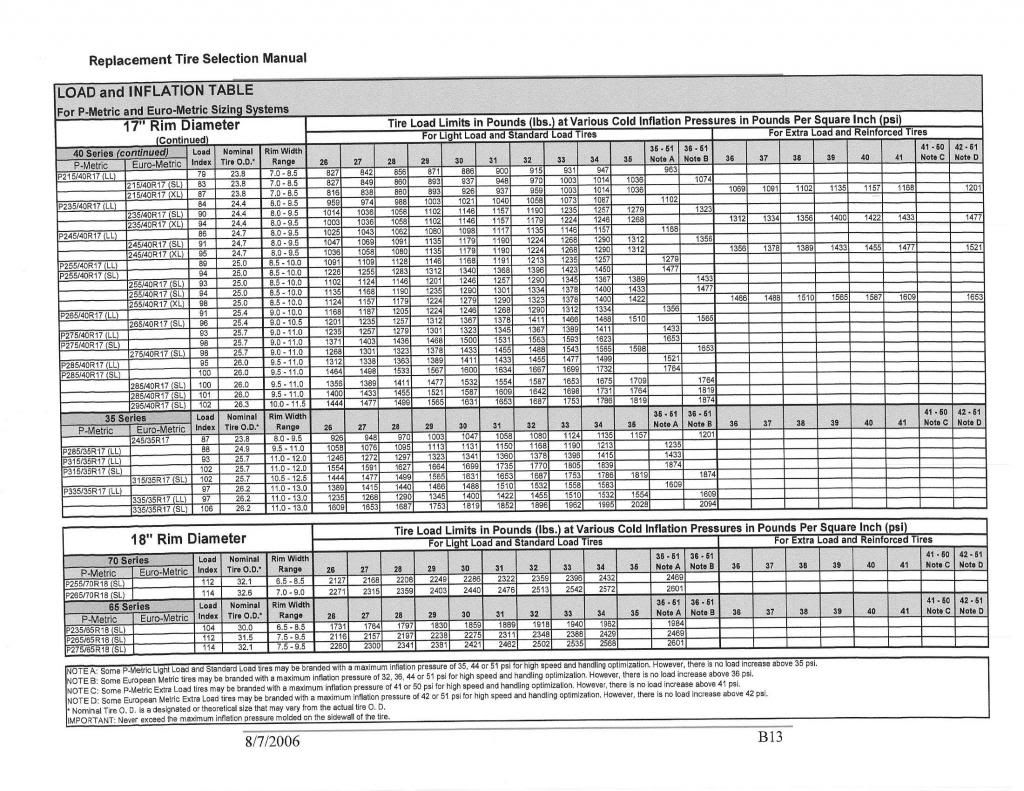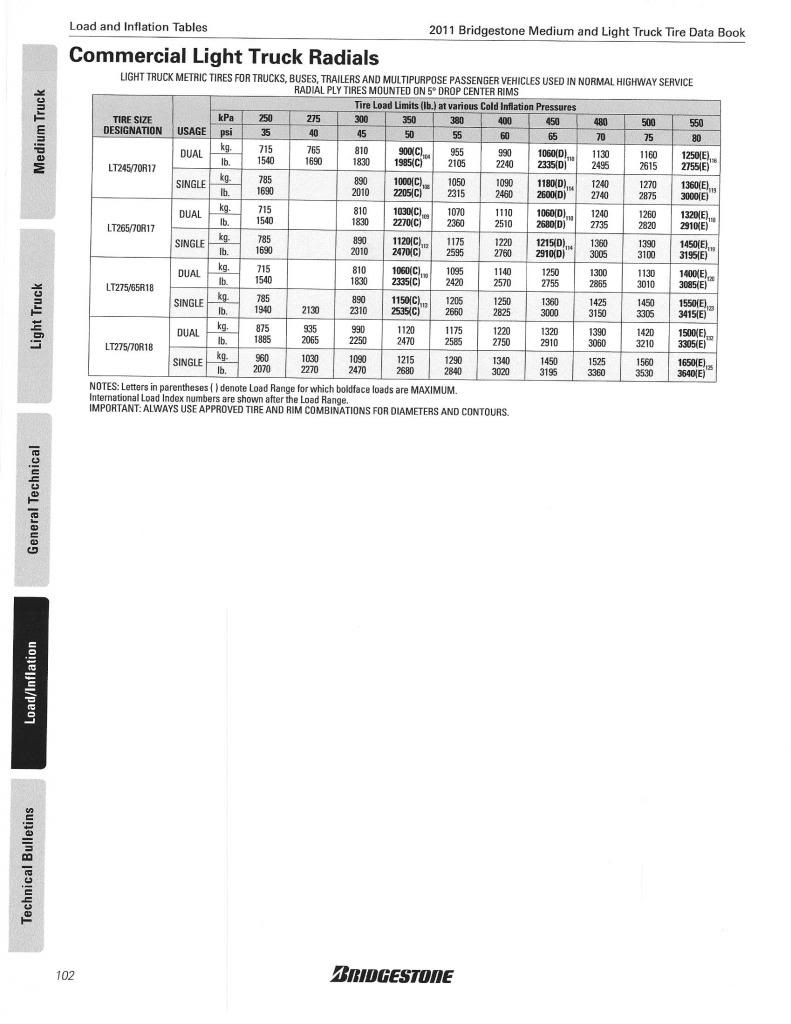Tire Pressure?
#11
Senior Member
i run 45 in all on my 285/70/17 Kanati 10 ply
#12
All Around Cool Guy
It has nothing to do with it being a d or e rated tire. If your vehicle says 35 on the door jam that is the recommended air pressure to support the weight of the vehicle no matter what the tire size is. Now if you do haul stuff or pull a trailer you can run them at a higher psi. If I ran 80 lbs in my 33s like my tire said my truck wouldn't stay on the ground. I have always ran the recommended by the truck in my oversized e rated tires and have never had a problem with them wearing out
I would be more than willing to tell you exactly how much air you would need to match OE specs with tire size and load range change if you give me the stock size and air pressure and then your upgraded size.
I have an "Advanced Instructor Status" with the Tire Industry Association and I can assure you that this info is 100% accurate.
The following users liked this post:
techrep (01-25-2013)
#13
Cycle For Fun and Health
I have always gone 3 to 5 PSI above manufacturer recommendation for normal loads and driving. Tire wear has been even across the width and gas mileage slightly better.
#14
Senior Member
You've overlooked the very fact that were talking PSI or pounds per square inch. If the tire size changes from stock, the total amount of inches has also changed requiring a change in air pressure to hold the same amount of weight as stock. You also need to consider that LT tires hold different weight (in lbs) at the same pressure even on the same size tire. You will need to adjust the air PERIOD.
I would be more than willing to tell you exactly how much air you would need to match OE specs with tire size and load range change if you give me the stock size and air pressure and then your upgraded size.
I have an "Advanced Instructor Status" with the Tire Industry Association and I can assure you that this info is 100% accurate.
I would be more than willing to tell you exactly how much air you would need to match OE specs with tire size and load range change if you give me the stock size and air pressure and then your upgraded size.
I have an "Advanced Instructor Status" with the Tire Industry Association and I can assure you that this info is 100% accurate.
The following users liked this post:
AKA_Kal_El (01-25-2013)
#15
All Around Cool Guy
Increasing pressure by a few pounds will add a few MPG's without affecting ride, or more importantly (to me and what I do) tire wear and in fact I recommend it. I run all my vehicles about 4 lbs high.
So in short, you are 100% correct!
(Hopefully now we all know why)
#16
I Like Tires
You've overlooked the very fact that we’re talkingPSI or pounds per square inch. If the tire size changes from stock, the totalamount of inches has also changed requiring a change in air pressure to holdthe same amount of weight as stock. You also need to consider that LT tireshold different weight (in lbs) at the same pressure even on the same size tire.You will need to adjust the air PERIOD.
I would be more than willing to tell you exactly how much air you would needto match OE specs with tire size and load range change if you give me the stocksize and air pressure and then your upgraded size.
I have an "Advanced Instructor Status" with the Tire IndustryAssociation and I can assure you that this info is 100% accurate.
I have an "Advanced Instructor Status" with the Tire IndustryAssociation and I can assure you that this info is 100% accurate.
We are in constant contact with Tire Manufacturers, the Rubber Manufacturers Association, and we physically test every tire we sell. My store is also one of the highest grossing of the company routinely selling $1Million dollars in tires a month. We do a lot of cars.
Refer to these charts, they are what you suggested posting yourself.
In chart 1 you will see towards the bottom:
A P-Metric 275/65/18 tire @35 psi will hold 2601lbs. Also take note that P-Metric tires do not gain any extra load capacities when being aired up to 44or 51 psi. 35 is the max pressure for load bearing. These higher pressures are purely to achieve high speed ratings and improve handling characteristics.
In chart 2 you will see:
An LT 275/65/18 LRE tire will hold 1940lbs @35 psi. Now you will notice that yes it is holding less weight @35 psi than the P-Metric, but last time I checked 8000lbs (4x tires at just under 2000lbs each) is far from my 7200lbs GVWR. And we are discussing an empty truck here for daily commuting so the difference only increases. The truck isn't going to weigh more than 6k lbs empty so the tires can easily handle the weight.
Now obviously you need to use some common sense when airing up the tires, if you are hauling a trailer or large load, then yes increase your tire pressure to reduce flex and improve handling.
But again we are discussing an EMPTY TRUCK FOR DAILY COMMUTING. I air these vehicles up every day and the customer will tell me to "Put the tires @ 80psi on his half ton truck because the sidewall says to". If I put it at 35psi he can't tell the difference by looking at them. Except that it suddenly rides WAAAAYYYY nicer and the center of his tread isn't prematurely wearing out. Now ultimately I just do whatever makes the customer happy but I will discuss with them why such apressure is unnecessary and the consequences he could face of running the tire at said pressure.
Also LT tires are just naturally so much stronger than P-Metric. Go find a LT and P of the same size manufacturer and model. Feel the difference in the sidewall. Stand the LT tire on its tread and step on top of the tire and notice how the tire hardly gives way if at all. Then do the same for the P Metric and
notice how it nearly folds in on itself under your weight.
I run my LRE tires at 40-45 but I have stuff in my bed on a regular basis so I will do around 35-40 in the front and 40-45 in the rear. Thats all you need.
I've shown you data clearly showing the tire easily handles the load at my suggested pressure and clearly show first hand experience since not a single car leaves our bay without the air pressure being set. So if you wish to continue to try and refute this be my guest. If you want to run the pressure a little over Great! A moderate increase won't hurt a thing, but these trucks are light. The more you air it up the more you risk wearing out the center of the tread.


Last edited by BassAckwards; 01-26-2013 at 12:39 AM.
#18
As for the running higher PSI or lower PSI, just play with it and see what works best for you.
#19
All Around Cool Guy
@ BassAkwards-
A few questions...
What info did I give that was incorrect?
Did I state something that warranted your question regarding "if I would like to refute these facts"?
I gave solid advice & even offered to do the weight conversion (to oe specs) for anyone who wanted that info.
You seem as if you were looking to "one up" someone.
I was answering a question as helpfully as I could.
I apologize if my answers seemed as if I wanted to engage in an argument.
A few questions...
What info did I give that was incorrect?
Did I state something that warranted your question regarding "if I would like to refute these facts"?
I gave solid advice & even offered to do the weight conversion (to oe specs) for anyone who wanted that info.
You seem as if you were looking to "one up" someone.
I was answering a question as helpfully as I could.
I apologize if my answers seemed as if I wanted to engage in an argument.
Last edited by AKA_Kal_El; 01-26-2013 at 01:31 AM. Reason: In correct post response
#20
I Like Tires
@ BassAkwards-
A few questions...
What info did I give that was incorrect?
Did I state something that warranted your question regarding "if I would like to refute these facts"?
I gave solid advice & even offered to do the weight conversion (to oe specs) for anyone who wanted that info.
You seem as if you were looking to "one up" someone.
I was answering a question as helpfully as I could.
I apologize if my answers seemed as if I wanted to engage in an argument.
A few questions...
What info did I give that was incorrect?
Did I state something that warranted your question regarding "if I would like to refute these facts"?
I gave solid advice & even offered to do the weight conversion (to oe specs) for anyone who wanted that info.
You seem as if you were looking to "one up" someone.
I was answering a question as helpfully as I could.
I apologize if my answers seemed as if I wanted to engage in an argument.
Factually you stated nothing incorrect. I thought you had made a post earlier in the thread suggesting a high tire pressure for the empty vehicle and I was incorrect so I must apologize to you.
What I was trying to get at was that inflating to more than 35psi is not necessary and that with any more you only risk wearing out your tread prematurely.
Unfortunately I see people saying all the time that they want 70+ psi in their half ton trucks or that their buddy said thats how much they need and that is one of my biggest pet peeves because this is why people wear out their tires so fast (That and just never checking their air pressure period) which unfortunately made me act a little hasty in my post quoting you.
So again I apologize I thought you were suggesting an unneccesary air pressure but you in fact did not and nothing you posted was factually incorrect. It was 100% accurate as you stated earlier.
All that said, If your truck is just a commuter vehicle and is empty most of the time, even with your LT A/T tires 35psi is all you need. That is my suggestion. Use the data I provided above to make your own informed decision based on your needs.
The following users liked this post:
AKA_Kal_El (01-26-2013)



